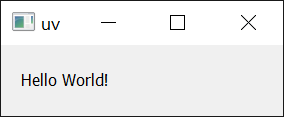运行脚本
Python 脚本是旨在独立执行的文件,例如,通过 python <script>.py。使用 uv 执行脚本可确保脚本依赖项得到管理,而无需手动管理环境。
Note
如果您不熟悉 Python 环境:每个 Python 安装都有一个可以安装包的环境。通常,建议创建虚拟 环境来隔离每个脚本所需的包。uv 会自动为您管理虚拟环境,并倾向于使用声明式方法来处理依赖项。
运行无依赖的脚本
如果您的脚本没有依赖项,您可以使用 uv run 来执行它:
同样,如果您的脚本依赖于标准库中的模块,则无需执行任何其他操作:
可以向脚本提供参数:
此外,您的脚本可以直接从 stdin 读取:
或者,如果您的 shell 支持 here-documents:
请注意,如果您在_项目_(即包含 pyproject.toml 的目录)中使用 uv run,它将在运行脚本之前安装当前项目。如果您的脚本不依赖于项目,请使用 --no-project 标志跳过此操作:
$ # Note: the `--no-project` flag must be provided _before_ the script name.
$ uv run --no-project example.py
有关在项目中工作的更多详细信息,请参阅项目指南。
运行带依赖的脚本
当您的脚本需要其他包时,必须将它们安装到脚本运行的环境中。uv 倾向于按需创建这些环境,而不是使用手动管理依赖项的长期虚拟环境。这需要显式声明脚本所需的依赖项。通常,建议使用项目或内联元数据来声明依赖项,但 uv 也支持按次调用请求依赖项。
例如,以下脚本需要 rich。
import time
from rich.progress import track
for i in track(range(20), description="For example:"):
time.sleep(0.05)
如果在未指定依赖项的情况下执行,此脚本将失败:
$ uv run --no-project example.py
Traceback (most recent call last):
File "/Users/astral/example.py", line 2, in <module>
from rich.progress import track
ModuleNotFoundError: No module named 'rich'
使用 --with 选项请求依赖项:
如果需要特定版本,可以向请求的依赖项添加约束:
可以通过重复使用 --with 选项来请求多个依赖项。
请注意,如果在_项目_中使用 uv run,这些依赖项将 另外 包含在项目的依赖项中。要选择退出此行为,请使用 --no-project 标志。
创建 Python 脚本
Python 最近添加了一种用于内联脚本元数据的标准格式。它允许选择 Python 版本和定义依赖项。使用 uv init --script 来使用内联元数据初始化脚本:
声明脚本依赖项
内联元数据格式允许在脚本本身中声明脚本的依赖项。
uv 支持为您添加和更新内联脚本元数据。使用 uv add --script 来声明脚本的依赖项:
这将在脚本顶部添加一个 script 部分,使用 TOML 声明依赖项:
# /// script
# dependencies = [
# "requests<3",
# "rich",
# ]
# ///
import requests
from rich.pretty import pprint
resp = requests.get("https://peps.python.org/api/peps.json")
data = resp.json()
pprint([(k, v["title"]) for k, v in data.items()][:10])
uv 将自动创建一个包含运行脚本所需依赖项的环境,例如:
$ uv run example.py
[
│ ('1', 'PEP Purpose and Guidelines'),
│ ('2', 'Procedure for Adding New Modules'),
│ ('3', 'Guidelines for Handling Bug Reports'),
│ ('4', 'Deprecation of Standard Modules'),
│ ('5', 'Guidelines for Language Evolution'),
│ ('6', 'Bug Fix Releases'),
│ ('7', 'Style Guide for C Code'),
│ ('8', 'Style Guide for Python Code'),
│ ('9', 'Sample Plaintext PEP Template'),
│ ('10', 'Voting Guidelines')
]
Important
使用内联脚本元数据时,即使在_项目_中使用 uv run,项目的依赖项也将被忽略。不需要 --no-project 标志。
uv 还尊重 Python 版本要求:
# /// script
# requires-python = ">=3.12"
# dependencies = []
# ///
# 使用 Python 3.12 中添加的一些语法
type Point = tuple[float, float]
print(Point)
Note
即使为空,也必须提供 dependencies 字段。
uv run 将搜索并使用所需的 Python 版本。如果未安装,将下载 Python 版本 — 有关更多详细信息,请参阅有关 Python 版本的文档。
使用 shebang 创建可执行文件
可以添加 shebang 使脚本无需使用 uv run 即可执行 — 这使得运行位于 PATH 或当前文件夹中的脚本变得容易。
例如,创建一个名为 greet 的文件,其内容如下
确保您的脚本是可执行的,例如,使用 chmod +x greet,然后运行脚本:
在此上下文中也支持声明依赖项,例如:
#!/usr/bin/env -S uv run --script
#
# /// script
# requires-python = ">=3.12"
# dependencies = ["httpx"]
# ///
import httpx
print(httpx.get("https://example.com"))
使用备用包索引
如果您希望使用备用包索引来解析依赖项,您可以使用 --index 选项提供索引:
这会将包数据包含在内联元数据中:
如果您需要身份验证才能访问包索引,请参阅包索引文档。
锁定依赖项
uv 支持使用 uv.lock 文件格式为 PEP 723 脚本锁定依赖项。与项目不同,脚本必须使用 uv lock 显式锁定:
运行 uv lock --script 将在脚本旁边创建一个 .lock 文件(例如,example.py.lock)。
一旦锁定,后续操作(如 uv run --script、uv add --script、uv export --script 和 uv tree --script)将重用锁定的依赖项,并在必要时更新锁文件。
如果不存在此类锁文件,uv export --script 等命令仍将按预期运行,但不会创建锁文件。
提高可复现性
除了锁定依赖项外,uv 还支持内联脚本元数据的 tool.uv 部分中的 exclude-newer 字段,以限制 uv 仅考虑在特定日期之前发布的发行版。这对于在稍后的时间点运行时提高脚本的可复现性很有用。
日期必须指定为 RFC 3339 时间戳
(例如,2006-12-02T02:07:43Z)。
# /// script
# dependencies = [
# "requests",
# ]
# [tool.uv]
# exclude-newer = "2023-10-16T00:00:00Z"
# ///
import requests
print(requests.__version__)
使用不同的 Python 版本
uv 允许在每次脚本调用时请求任意 Python 版本,例如:
有关请求 Python 版本的更多详细信息,请参阅 Python 版本请求文档。
使用 GUI 脚本
在 Windows 上,uv 将使用 pythonw 运行以 .pyw 扩展名结尾的脚本:
from tkinter import Tk, ttk
root = Tk()
root.title("uv")
frm = ttk.Frame(root, padding=10)
frm.grid()
ttk.Label(frm, text="Hello World").grid(column=0, row=0)
root.mainloop()

同样,它也适用于依赖项:
import sys
from PyQt5.QtWidgets import QApplication, QWidget, QLabel, QGridLayout
app = QApplication(sys.argv)
widget = QWidget()
grid = QGridLayout()
text_label = QLabel()
text_label.setText("Hello World!")
grid.addWidget(text_label)
widget.setLayout(grid)
widget.setGeometry(100, 100, 200, 50)
widget.setWindowTitle("uv")
widget.show()
sys.exit(app.exec_())

后续步骤
要了解有关 uv run 的更多信息,请参阅命令参考。
或者,继续阅读以了解如何使用 uv 运行和安装工具。